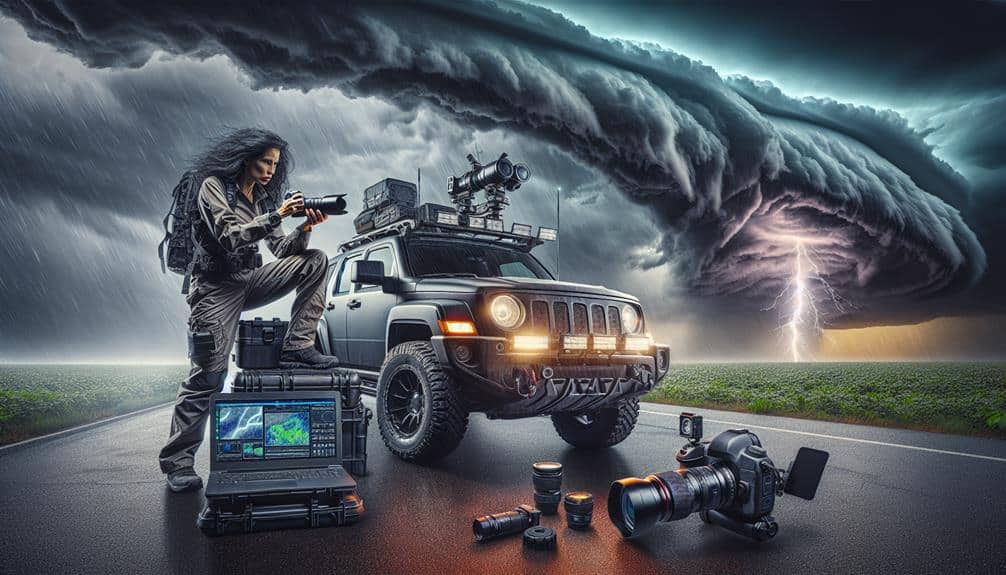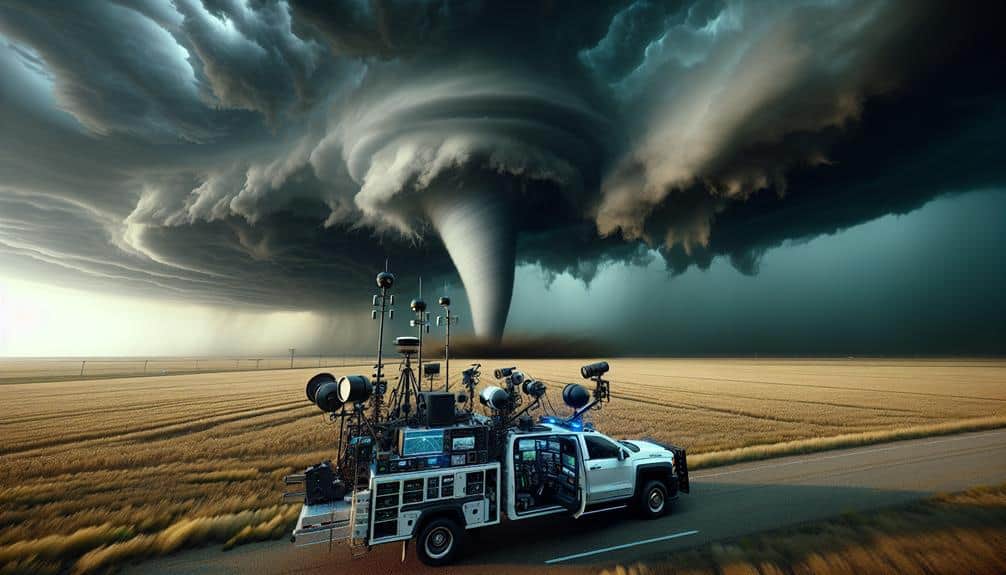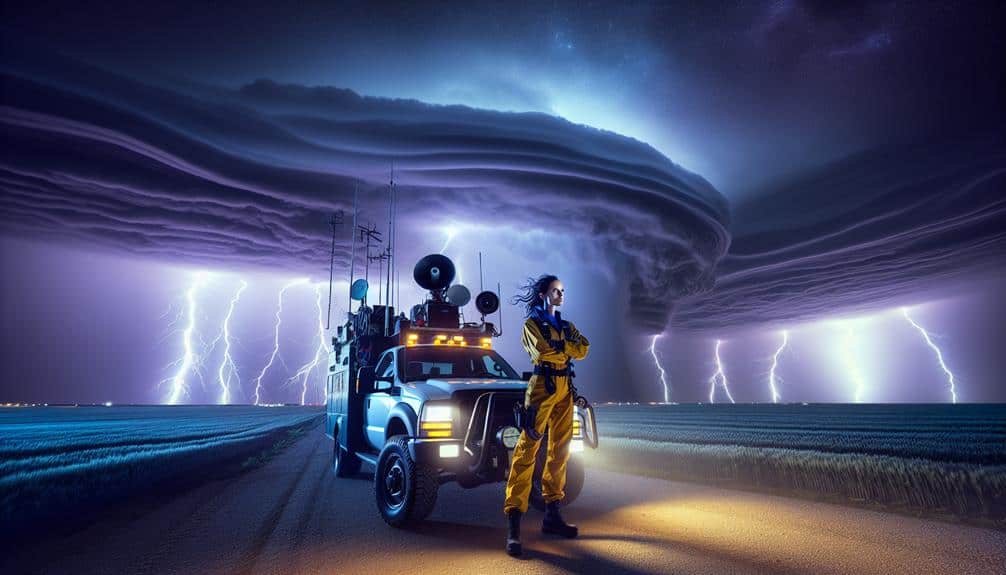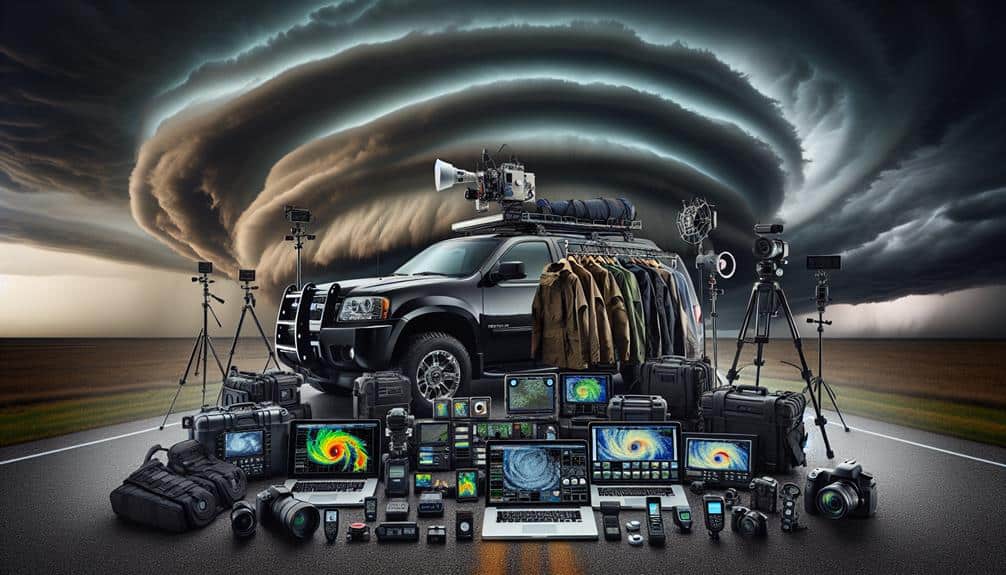To join a storm chaser team, we need to grasp core meteorological principles, involving data interpretation from satellites and Doppler radar. Training in weather modeling, obtaining certifications from reputable meteorological institutions, and gaining hands-on experience through internships or shadowing are important steps. Evaluating team credentials, their scientific expertise, and previous track records enhances our selection process. Essential equipment, such as GPS, anemometers, and Doppler radar units, guarantees accurate data collection. Stringent safety protocols and protective gear are mandatory to withstand severe weather conditions. By focusing on these elements, we can prepare ourselves for the multifaceted demands of storm chasing and discover further insights.
Key Points
- Obtain certification from recognized meteorological institutions and gain proficiency in interpreting weather data.
- Gain hands-on experience through internships and shadowing experienced storm chasers.
- Research team credentials, including experience levels, published research, and affiliations with meteorological organizations.
- Undergo thorough training programs that cover advanced meteorological coursework, physical conditioning, and simulated storm-chasing exercises.
Understanding Storm Chasing Basics
To comprehend storm chasing basics, we must first grasp the meteorological principles that govern severe weather phenomena. Storm tracking relies on analyzing weather patterns, which are fundamentally the atmospheric conditions over a specific area over a certain period. We need to interpret data from satellites, radar, and weather stations to predict storm development, trajectory, and intensity.
When we examine weather patterns, it's vital to identify key indicators such as temperature gradients, humidity levels, and wind shear. These factors contribute to the formation of thunderstorms, tornadoes, and other severe weather events. By studying these elements, we can pinpoint regions where storms are likely to initiate and evolve.
Utilizing advanced tools like Doppler radar, we can measure the velocity and direction of storm cells. This technology enables us to track storms in real-time, providing us with essential information on their speed, path, and potential impact areas.
In our pursuit of freedom and adventure, understanding these meteorological principles allows us to safely and effectively chase storms. Accurate storm tracking not only enhances our safety but also enables us to contribute valuable data to the scientific community, improving future weather forecasting models.
Required Skills and Training
Mastering the meteorological principles behind storm chasing is just the starting point; acquiring the necessary skills and specialized training is equally essential for becoming a proficient storm chaser. We must first gain a solid understanding of meteorological data interpretation, including radar analysis and weather modeling. Proficiency in these skills enables us to predict storm behavior accurately.
Obtaining certification from recognized meteorological institutions also bolsters our qualifications. Programs like SKYWARN or formal meteorology degrees can provide this certification. These programs often include rigorous training modules focusing on storm structure, safety protocols, and emergency response.
Hands-on experience is another vital component. Participating in internships or shadowing experienced storm chasers allows us to apply theoretical knowledge in real-world scenarios. This experience is invaluable when dealing with the unpredictable nature of storms.
To join reputable storm chasing teams, we often face stringent interview requirements. These typically assess our qualifications, including prior experience, specialized training, and certifications. Demonstrating our ability to remain calm under pressure and make quick, informed decisions is essential during these interviews.
In essence, acquiring the necessary skills, certifications, and practical experience forms the backbone of our journey to becoming adept storm chasers, ready to face nature's most formidable challenges.
Finding Reputable Teams
We should prioritize researching team credentials by verifying certifications and affiliations with meteorological institutions.
Examining experience levels is crucial, focusing on the number of storms tracked and years in operation.
Additionally, let's contact previous members to gather qualitative data on team dynamics and safety protocols.
Research Team Credentials
Evaluating storm chaser teams requires scrutinizing their scientific credentials, including the team's expertise, published research, and affiliations with recognized meteorological institutions.
Let's consider the importance of team qualifications and research experience. Teams with advanced degrees in meteorology, atmospheric science, or related fields demonstrate a strong foundation in understanding storm dynamics. Reviewing their published research in peer-reviewed journals provides insights into their contribution to the field and their commitment to advancing scientific knowledge.
We should also examine affiliations with respected meteorological organizations such as the American Meteorological Society (AMS) or the National Weather Association (NWA). These affiliations often indicate adherence to rigorous scientific standards and ethical practices.
Additionally, teams that participate in collaborative research projects, like those sponsored by the National Oceanic and Atmospheric Administration (NOAA), highlight a dedication to substantial, impactful research.
Check Experience Levels
Assessing the experience levels of storm chaser teams involves scrutinizing their track record, past fieldwork, and documented storm encounters to ensure they possess the practical expertise necessary for effective storm analysis. We must meticulously perform a skill assessment to determine the depth of their meteorological knowledge and the breadth of their hands-on experience. This involves examining the number of years they've been active, the variety of storm types they've encountered, and the precision of their data collection methodologies.
Experience verification is equally vital. We need to look at their documented storm pursuits, including video footage, data logs, and published research. Analyzing these records helps us gauge their proficiency in navigating severe weather conditions and implementing safety protocols. High-quality teams will have a robust portfolio showcasing successful chase operations and minimal incidents.
Moreover, cross-referencing their participation in professional meteorological organizations and conferences can provide additional credibility. Teams with members who frequently present findings or collaborate on scientific studies tend to have a higher level of expertise.
Contact Previous Members
To identify reputable storm chaser teams, reaching out to former members provides invaluable insights into the team's operational integrity and expertise. By engaging in direct communication with past participants, we can gather specific data on the team's track record, safety protocols, and overall experience. This process facilitates networking opportunities and advice sharing, crucial for making an informed decision.
One effective method is to utilize social media platforms and professional forums dedicated to storm chasing. These digital spaces often host a wealth of information from seasoned chasers, who are typically open to experience exchange. By posing targeted questions about their tenure with specific teams, we can extract precise information regarding team dynamics, leadership quality, and logistical efficiency.
Moreover, building these connections enriches our knowledge base and enhances our analytical approach. Former members can offer firsthand accounts of various scenarios, such as navigating severe weather conditions or managing emergency situations. This connection building not only bolsters our confidence but also arms us with critical data to assess the feasibility of joining certain teams.
Ultimately, contacting former members acts as an essential step in our pursuit of freedom and adventure, ensuring we align with teams that meet our standards of excellence and safety.
Application and Selection Process
The application and selection process for joining storm chaser teams involves a rigorous evaluation of candidates' meteorological expertise, physical fitness, and situational awareness. We start with an interview process designed to assess an applicant's knowledge of meteorological phenomena, verifying they possess the analytical skills needed to interpret complex weather data. This phase also evaluates team dynamics, as effective communication and collaboration are crucial in high-stress environments.
Selection criteria are strict. Candidates must demonstrate proficiency in meteorological software, exhibit robust physical fitness to handle demanding conditions, and possess acute situational awareness to make quick, informed decisions. During this stage, we also emphasize psychological resilience, given the high-pressure scenarios encountered in the field.
Training requirements are extensive. Once selected, candidates undergo a thorough training program that includes advanced meteorological coursework, physical conditioning regimes, and simulated storm-chasing exercises. These training sessions aim to refine technical skills and reinforce the importance of teamwork and safety protocols.
Essential Gear and Equipment

Outfitting our storm chaser teams with essential gear and equipment is crucial for guaranteeing both safety and operational efficiency in the field. Our gear selection focuses on high durability and functionality to withstand extreme weather conditions. Key items include weather-resistant clothing, GPS navigation systems, and handheld anemometers for accurate wind speed measurements. Additionally, we rely on mobile Doppler radar units to provide real-time data on storm development.
Equally important is the use of rugged laptops and tablets equipped with specialized meteorological software. These devices enable us to analyze data on the go, guaranteeing we make informed decisions. Communication tools, such as satellite phones and two-way radios, are necessary for maintaining contact with team members and emergency services.
Equipment maintenance is another crucial aspect. Regular inspections and calibrations are essential to ensure the accuracy and reliability of our instruments. For instance, we routinely check the calibration of our anemometers and Doppler radar units to guarantee they provide precise data. Battery management is also important; all electronic gear must have fully charged spare batteries to avoid downtime.
Safety Protocols and Best Practices
Let's start by emphasizing the critical importance of essential safety gear, which includes items such as helmets, reinforced clothing, and first aid kits, as these can greatly reduce injury risk.
We must also establish robust communication and coordination protocols, utilizing GPS systems and radio frequencies to guarantee real-time data sharing and team synchronization.
Essential Safety Gear
Every storm chaser must prioritize essential safety gear to mitigate risks and guarantee operational efficiency during severe weather events. We need to equip ourselves with protective clothing designed to withstand high winds, heavy rain, and flying debris. This includes waterproof jackets, sturdy boots, and helmets. These items, built from resilient materials, greatly reduce the likelihood of injury.
Emergency supplies are equally important. We should carry sufficient food, water, and blankets to sustain us if we get stranded. Given the unpredictability of severe weather, having these supplies can mean the difference between safety and peril.
Communication devices are necessary for our operations. Reliable two-way radios ensure we maintain contact with team members and receive real-time updates on weather conditions. Satellite phones offer a backup when cellular networks fail, maintaining our ability to communicate.
A first aid kit is essential. Stocked with bandages, antiseptics, pain relievers, and necessary medications, it allows us to address minor injuries immediately, preventing complications.
Communication and Coordination
Implementing rigorous communication and coordination protocols is essential for ensuring the safety and effectiveness of our storm chasing operations. Our team dynamics rely on seamless collaboration, leveraging both verbal and non-verbal cues to maintain situational awareness. This involves utilizing advanced communication tools like satellite phones and two-way radios, ensuring redundancy in case primary systems fail. Effective communication is paramount; we need to transmit meteorological data, positional coordinates, and tactical decisions with precision and speed.
We adhere to structured communication protocols, including predefined codewords and brevity codes, to minimize misunderstandings during high-pressure scenarios. Our teamwork benefits from regular drills that simulate various storm scenarios, enhancing our ability to respond swiftly and cohesively. Each team member has a designated role, from data analysis to piloting drones, ensuring each task is executed without overlap or confusion.
Additionally, real-time data sharing through GPS tracking apps and meteorological software enhances our coordination, allowing for dynamic adjustments to our chase strategy. By fostering an environment where every member's input is valued, we boost both morale and operational efficiency. In this high-stakes field, our commitment to rigorous communication and coordination protocols can be the difference between success and calamity.
Frequently Asked Questions
What Are the Typical Costs Associated With Joining a Storm Chaser Team?
The financial implications include equipment expenses ranging from $2,000 to $5,000. Training requirements and skill development can cost an additional $500 to $2,000. It's important we analyze these costs to make sure we're prepared for the commitment and potential risks.
How Much Time Commitment Is Expected From a Storm Chaser Team Member?
How much time commitment is expected? We typically dedicate 15-20 hours weekly, balancing training requirements with real-time monitoring. Flexibility is key, as teamwork dynamics shift rapidly. Adaptability guarantees we maximize safety and efficiency in the field.
Are There Any Age Restrictions for Joining a Storm Chaser Team?
We're analyzing age restrictions for joining storm chaser teams and note that training requirements and safety precautions vary. Most teams require members to be 18+ due to legal liabilities and the rigorous nature of storm chasing activities.
Can Storm Chasing Be Pursued as a Full-Time Career?
With over 1,200 tornadoes annually in the U.S., storm chasing offers career viability. We need rigorous training requirements, including meteorology and emergency response skills, for full-time engagement. Freedom in this field comes with precise, scientific preparation.
What Are the Legal Considerations or Permits Required for Storm Chasing?
For storm chasing, we must understand permit requirements and legal considerations. Local jurisdictions vary, so analyzing specific regional laws guarantees compliance. We should prioritize safety regulations and obtain necessary permits to chase storms legally and responsibly.


